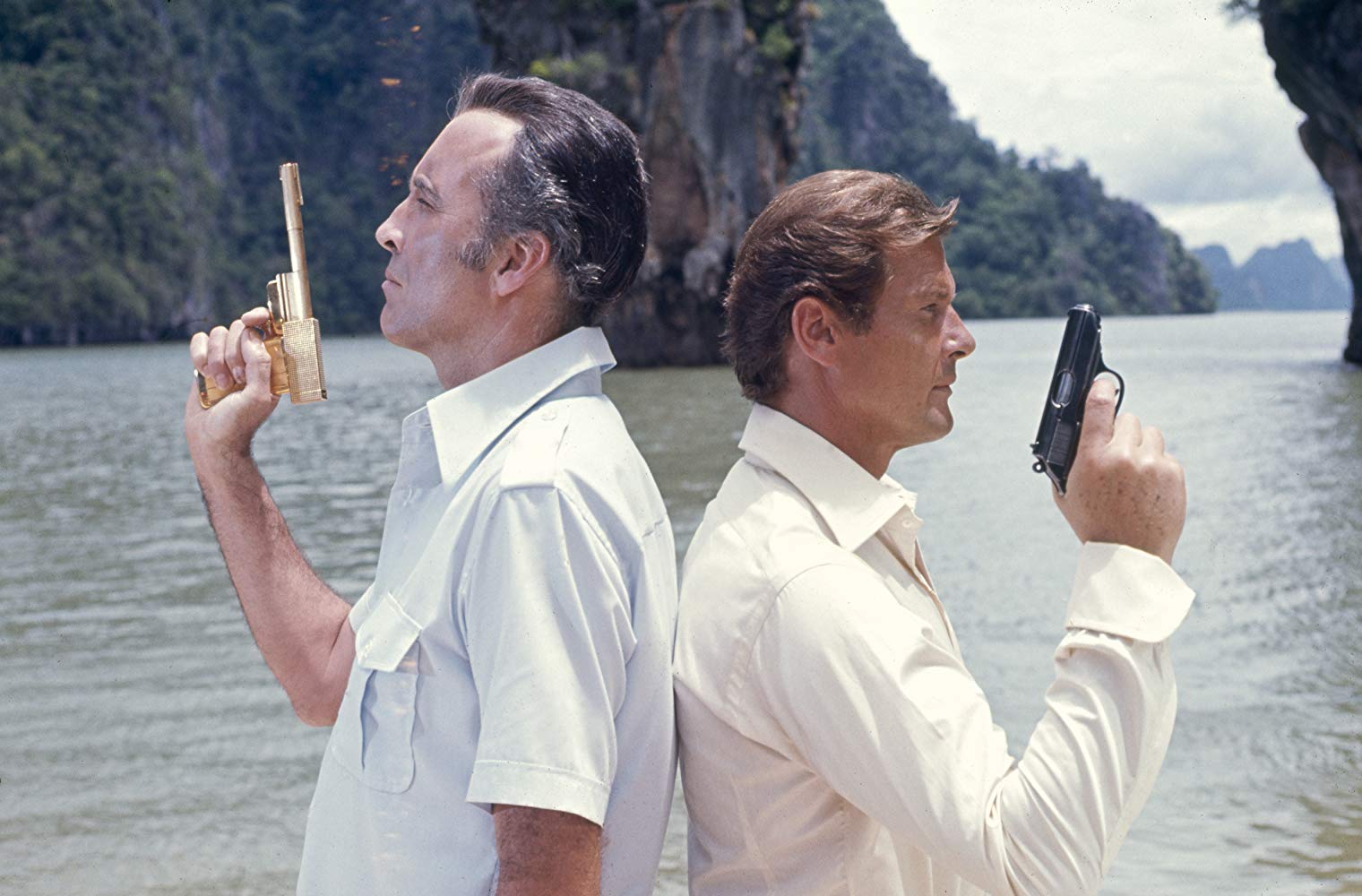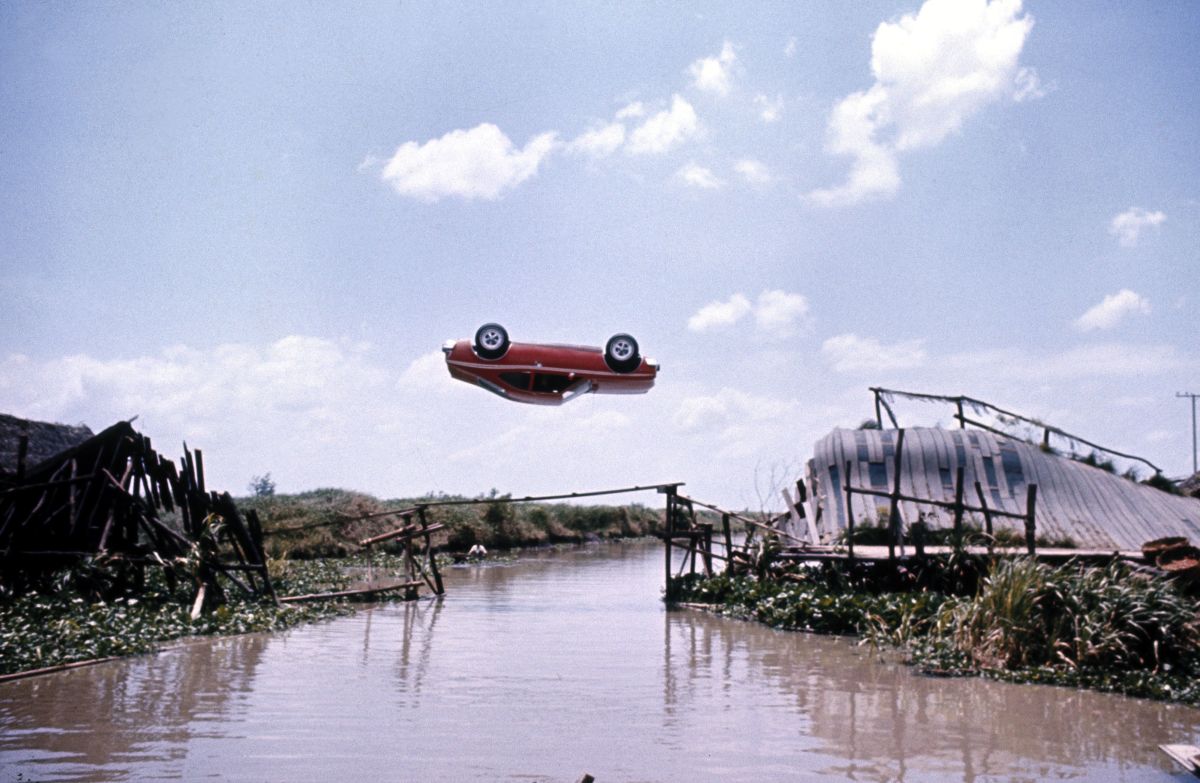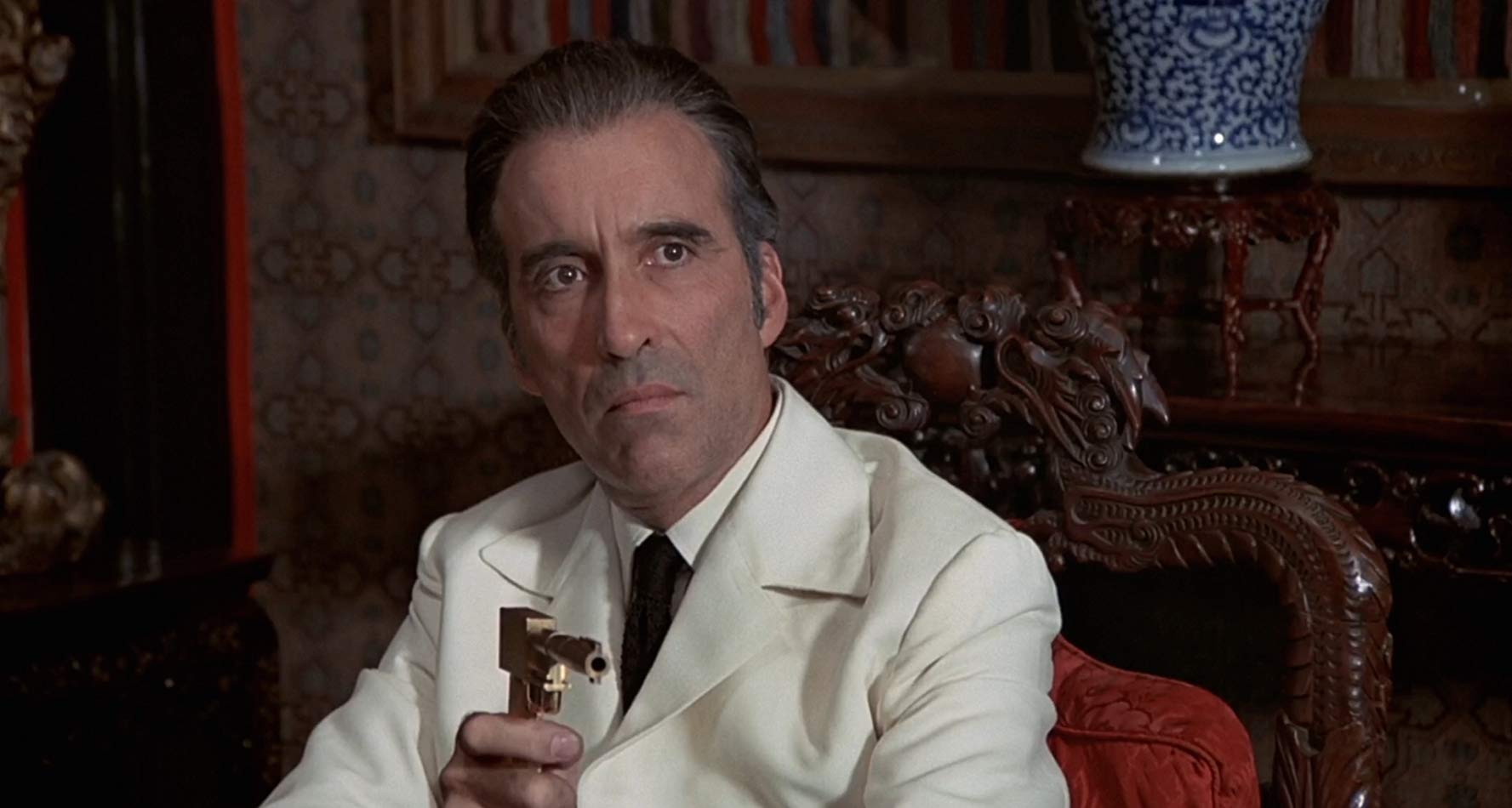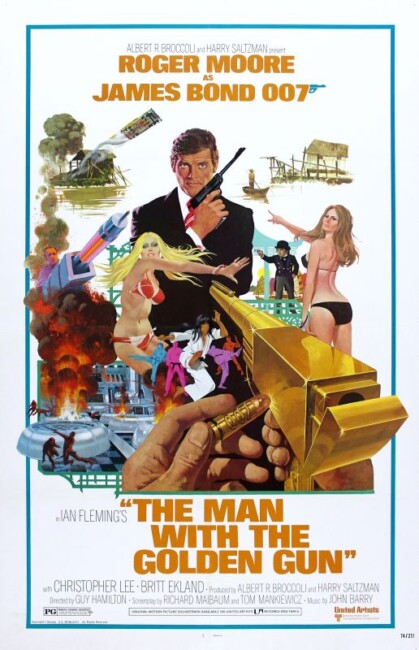Crew
Director – Guy Hamilton, Screenplay – Richard Maibaum & Tom Mankiewicz, Based on the Novel by Ian Fleming, Producers – Albert R. Broccoli & Harry Saltzman, Photography – Ted Moore & Oswald Morris, Music – John Barry, Miniature Effects – Derek Meddings, Special Effects Supervisor – John Stears, Production Design – Peter Murton. Production Company – Eon Productions.
Cast
Roger Moore (James Bond), Christopher Lee (Francisco Scaramanga), Britt Ekland (Mary Goodnight), Maud Adams (Andrea Anders), Herve Villechaize (Nick Nack), Bernard Lee (M), Soon Taik Oh (Lieutenant Hip), Clifton James (Sheriff J.W. Pepper), Richard Loo (Hai Fat), Desmond Llewellyn (Q), Lois Maxwell (Miss Moneypenny)
Plot
James Bond receives a bullet made of gold with his name carved on it. This is the calling card of Francisco Scaramanga, the world’s highest paid assassin who commands a million dollars a hit. Deciding to head Scaramanga off by finding him first, Bond travels to Hong Kong in search of the bullet-maker. There, as Bond traces Scaramanga’s trail, both he and Scaramanga end up competing for possession of the Solex Agitator, a device wanted by Scaramanga to power the giant laser at his hideout on an island in the Red China Sea.
The Man with the Golden Gun was the ninth of the James Bond films. By general consensus, The Man with the Golden Gun vies with Moonraker (1979) and A View to a Kill (1985) as the worst of the series. It was Roger Moore’s second outing as Bond and one can see the beginnings of the campy elements that would find grand flowering in his later entries. It also marked the final pairing of producers Albert R. Broccoli and Harry Saltzman, who had worked together since the beginning of the James Bond series in 1962 but parted ways after this. Broccoli continued to produce the series on his own up until 1989.
Perhaps what is saddest about The Man with the Golden Gun is how widely it misses its potential to have been a great James Bond film. Ian Fleming never got it quite right in the book either – Fleming’s excuse was that he was ill during the writing of it and left the book uncompleted beyond a first draft when he died of a heart-attack in 1964, which was published in 1965. The film bears little semblance to the book – only retaining the character of the assassin Scaramanga and his golden gun, the name of the love interest Mary Goodnight and nothing else.
Certainly, the idea of Bond being pitted up against the world’s greatest assassin has marvellous potential. The Man with the Golden Gun could have been a James Bond film that worked like From Russia with Love (1963), a story that did not need cartoonish super-villains or grand-sized world domination schemes, one that could have instead been played purely as a battle of wits between two equally skilled opponents.

Only it isn’t. Instead, Broccoli and Saltzman play The Man with the Golden Gun as the same old big-budget James Bond cartoon – but they fail to even do that well. Instead of a grand battle of psychological wits that the idea promises, we just get Broccoli and Saltzman going through what had by now become the Bond formula.
Christopher Lee is outfitted with a giant-sized mad scientist’s laboratory for the sole reason that the series’ formula dictates that a giant set must go up in an explosion at the climax – but this is something that clashes badly with the character who is supposed to be a world-class assassin, not a scientist or a megalomaniac with world-dominating ambitions. Notedly the big climax of the film is not the shootout between Bond and Scaramanga but Bond and Mary’s escape from Scaramanga’s exploding hideout. The film doesn’t need the Solex Agitator subplot, it could have worked perfectly well as a realist Bond film – it is just the production team place their trust in size and spectacle rather than drama. Broccoli and Saltzman had been badly burned by this when they tried a character-driven Bond before in On Her Majesty’s Secret Service (1969), which through no fault of the approach, had been the lowest-grossing film of the entire Bond series. (Alas, The Man with the Golden Gun promptly became the second lowest grossing).
Even as the James Bond film formula goes, The Man with the Golden Gun is surprisingly dull. The action scenes are noticeably lacking – about all the film has to offer is a hardly exciting boat chase, a kung fu fight that is over in a matter of seconds and a car chase sequence that is moderately exciting. Even the climactic shootout showdown between Bond and Scaramanga ends with Bond dispatching Scaramanga with a single shot – no build-up, no fight between the two beforehand.

Guy Hamilton had previously directed Goldfinger (1964), the series zenith in terms of action and cool. It is sad to see that Guy Hamilton has somehow managed to scale both extremes of the James Bond series – to touch its peak with Goldfinger and to also direct this styleless exercise, which must be the series nadir.
The humour relies on the relentlessly lowbrow – an annoyingly racist gag about a kid trying to hustle wooden elephants to tourists and an unnecessary return appearance of Clifton James’s Sheriff Pepper from Live and Let Die (1973). About the only novelties the film has on show are its cartoonish gimmicks – Christopher Lee’s car that turns into a plane and the scene where Bond flips a car through a 360-degree horizontal rotation as he jumps between two bridges. When such ridiculous gimmicks are all that a film has to rely on, it is clear that creativity in the series has dried up.
Further indication of flagging creativity is surely the film’s choice of Hong Kong locations. As in the previously entry, Live and Let Die, which tried to cash in on the Blaxploitation movie fad, the Bond series increasingly appeared to be trying to introduce novelty by jumping onto other contemporary cinematic trends, in this case the burgeoning Hong Kong kung fu genre of the 1970s (only to do nothing with it).
The sets are expectedly lavish but, as with the interior of the Queen Mary, a ship’s interior built on a slanted angle, the effects are often more ridiculous than impressive. Roger Moore plays archly throughout. The puns and double-entendres are atrocious – Maud Adams pulls a pistol in the shower. “A water pistol?” Moore comments with curled eyebrow. Or, upon tossing away his fake nipple, “He must have found me titillating.” There is a Chinese girl named Chu Me, in what must surely be the most atrocious of the double-entendre women’s names that appear throughout the series.

Britt Ekland makes an appalling stab at a British accent and is possibly the most useless and instantly forgettable Bond girl of the entire series. Many fans regard Christopher Lee as one of the best Bond villains but in my opinion Lee is miscast as Scaramanga – while he carries the role off with Lee-like sinister dignity, the character generates little in the way of menace when on screen and lacks the larger than life quality of the great Bond villains like Goldfinger or Dr No. Christopher Lee’s villainy is something that needs the florid surrounds of the Hammer Gothic to emphasise his dark magnetism and The Man with the Golden Gun‘s fault is that fails to make the character of Scaramanga interesting enough for Lee to fill it. [In an interesting trivia note, Christopher Lee is Ian Fleming’s cousin and Fleming had originally pushed for Lee to play the title villain in the first Bond film Dr No (1962)].
The making of The Man with the Golden Gun was depicted in My Dinner with Herve (2017), a biopic of Herve Villechaise, later of tv’s Fantasy Island (1977-84) fame and here plays Christopher Lee’s henchman. The film recreates many scenes and casts Mark Umbers as Roger Moore.
The other James Bond films are:– Dr No (1962), From Russia with Love (non-genre, 1963), Goldfinger (1964), Thunderball (1965), You Only Live Twice (1967), On Her Majesty’s Secret Service (1969), Diamonds Are Forever (1971), Live and Let Die (1973), The Spy Who Loved Me (1977), Moonraker (1979), For Your Eyes Only (non-genre, 1981), Octopussy (1983), A View to a Kill (1985), The Living Daylights (non-genre, 1987), License to Kill (non-genre, 1989), GoldenEye (1995), Tomorrow Never Dies (1997), The World is Not Enough (1999), Die Another Day (2002), Casino Royale (non-genre, 2006), Quantum of Solace (non-genre, 2008), Skyfall (non-genre, 2012), Spectre (2015) and No Time to Die (2021). Casino Royale (1967) and Never Say Never Again (1983) are non-series Bond films. Everything or Nothing (2012) is a documentary about the Bond series.
Trailer here

